Our ocular prosthetics department is the largest of its type in the UK. The team here fits and manufactures a complete range of custom-made ocular prostheses (artificial eyes).
Artificial eyes can be provided to people who have had their eye removed (enucleated or eviscerated) which is very rare, or to people who have damaged eyes, small eyes, or other eye-related conditions.
Initially, a temporary prosthesis is provided from stock and will be worn until an individual custom-made prosthesis can be made. The custom-made prostheses are made from high quality cross-linked acrylic (glass eyes can also be arranged) and are individually fitted (moulded). They are manufactured by the ocularist in the department at Moorfields and hand painted in front of the patient. This ensures continuity of treatment and eliminates the inaccuracies that can occur when the prosthesis is manufactured at a separate location.
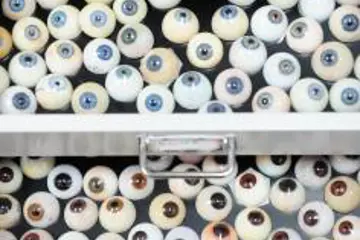
We also provide cosmetic shells. These are moulded and hand painted and are routinely manufactured in acrylic to less than one millimetre thickness. They can be made with optical corrections, clear pupils and as a solution to ptosis (droopy eyelids). They can also be fitted to microphthalmic (small eyes) or phthisical (wasted) eyes.
Facial prostheses are supplied normally following exenteration (the removal of the entire contents of the eye socket, including eyeball, muscles, fat and tissues) and can be constructed of acrylic and/or silicone rubber. They are positioned and held in place by adhesives or by attachment to spectacles. We can also provide prostheses that are attached to orbital bone retained implants for greater sophistication. These are all manufactured on site. The orbital area is moulded and the new face area sculpted in clay and wax to restore symmetry with the companion orbital area.
If a child is born with either anophthalmia (no eye/eyes) or microphthalmia (small eyes), the eye socket needs to be expanded to ensure that there is no residual orbital imbalance and to stimulate natural orbital and soft tissue development. This is achieved by various means over a period of days and weeks, depending on the individual case, to a point where a cosmetic prosthesis can be provided. This process needs repeating frequently to match the growth and stimulate socket expansion. Our ocularists and surgical team have a great deal of experience and expertise in these more difficult cases.
Peter Coggin, senior ocularist at Moorfields Eye Hospital, talks about the work done by the prosthetic department and how they work with patients to match and supply prosthetics to enable patients some form of symmetry to the facial area.
video transcript
We’re the biggest prosthetics department in the UK, we manufacture the prosthesis on site. There are seven of us, trained ocularist and we work over two sites. One at the adult hospital, one at the children’s centre. Last year we maned to supply 1,600 medical devices.
My day to day role at Moorfields is to fit both adults and children with what we call prosthetic devices, meaning patients that need to wear an artificial eye, or patients that need to wear a cosmetic shell. Where they do have an eye there, which is small in size, it’s just about creating facial symmetry for patients.
The techniques we use have always been the same from when I started. They’re all handed, they’re all hand crafted, they’re all individually made for the individual patients. When we first started in the children’s centre, we wanted to it as child friendly as possible for when the children arrive. So, we thought it was a good idea to have then draw pictures of themselves to put up on the wall with their own name on. Then we came up with the idea that we would require them to learn how to handle their prosthesis. So, it works for both of us in a way. Where it helped them to handle their prosthesis, inserting and removing t, which is very difficult or a child, and then they can come in and see their name on the wall. We’ve got picture in there that have been there for many, many years. The older patients would come in and see pictures, which they put up when they were babies. It’s quite eye catching for their and their parents and the children.
The most rewarding part of the job is seeing the satisfaction that we can give to our patients, seeing the fact that we make a difference to them. Obviously, I enjoy working with my hands and the painting skills that we use. So, it’s a very rewarding job.
How do I get an appointment with this service?
Patients can be referred to our ocular prosthetics team from other clinics within Moorfields, from other eye hospital departments or directly by their GP.
Prosthetic eye appointments
About Moorfields ocular prosthetics department
Moorfields ocular prosthetics department is the largest of its type in the UK. The team here fits and manufactures a complete range of custom-made ocular prostheses, (artificial eyes) as well as cosmetic shells. Our custom-made prostheses are made from high quality cross-linked acrylic and are individually moulded to your socket.
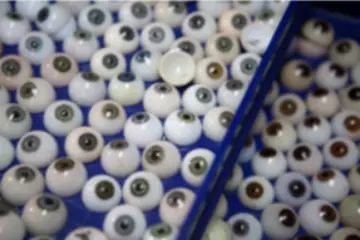
They are manufactured by the ocularist in the department at Moorfields City Road and hand painted in front of you. This ensures they area near perfect colour match to your natural eye. Due to the nature of our work, prosthetics can only be provided at City Road.
Your appointments at the ocular prosthetics department
Due to the length of our appointments, the ocular prosthetics department run a strict appointment system. If you arrive late, we may not be able to complete your treatment on the day and you may need to return for an additional appointment to complete the treatment. This will extend the treatment time frame mentioned below.
Six weeks post-op
At this appointment we will remove your conformer (clear shell placed in your socket during surgery) and fit a temporary prosthesis from our stock of pre-made artificial eyes.
We will teach you how to insert and remove this prosthesis (see ‘inserting and removing your prosthesis or cosmetic shell’ .
This appointment will last approximately one hour. After this appointment we will book your next appointment for approximately two months later.
Three and a half months post- op
At your second appointment, we will begin the process of making your custom-made eye. We will determine the shape of your socket by taking an impression and forming a wax shape or acrylic shell from it. An iris is then painted to match your natural eye; this is embedded into the new shape. The appointment will last approximately two hours.
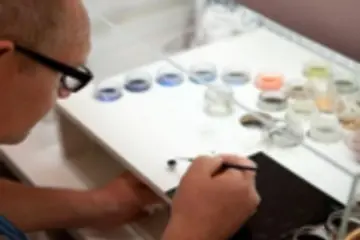
Please note that this prosthesis will need to be processed into acrylic plastic, which will take approximately six to eight weeks. You will leave this appointment today still wearing your temporary prosthesis.
Five to six months post-op.
You will return to the ocular prosthetics department to collect your finished custom-made prosthesis. Occasionally, the prosthesis may need adjustment to get the best possible fit or appearance, and because of this we may need to keep the prosthesis for a short time longer.
This section aims to provide specialist information and guidance for patients before and after having their eye removed (enucleation/ evisceration), or who are undergoing secondary ball implant surgery, dermis fat graft surgery or any other revision of socket surgery.
If you have any further questions after reading this page, please contact the ocular prosthetics team via the details provided.
Ocular prosthetics department
Visit us: first floor, Moorfields City Road.
Instructions for inserting and removing your prosthesis or cosmetic shell
You will be shown how to insert and remove your prosthesis by your ocularist. These instructions are to remind you how to do this correctly. The first diagram shows the anatomy of the normal eye and the second diagram shows the implant in the socket and the prosthesis before insertion.

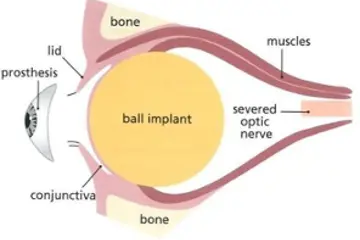
Fitting the prosthesis
The instructions are the same for whichever type of prosthesis you have had fitted. They are usually marked or shaped to help you tell which way around the prosthesis should be fitted:
- Conformer shells are pear-shaped and are fitted with the narrow end pointing towards the nose.
- Temporary artificial eyes normally have a black spot on the top edge.
- Artificial eyes and cosmetic shells normally have a serial number along the top edge.
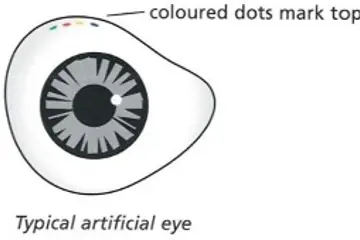
After washing your hands, wash your prosthesis with warm running water and liquid soap, washing up liquid or simple soap, and rinse thoroughly.
Holding the prosthesis between thumb and second finger of your dominant hand, rest your index finger on the centre of the prosthesis, making sure that the dots are visible. Put a second finger of your other hand on the centre of the eyelash and lift the upper lid.
Look down and insert the serial numbered edge of the shell under the lid. When the prosthesis is halfway in, let go of the top lid, but still hold the prosthesis in position with the finger of your dominant hand.
Look up and gently pull down the lower lid with the other hand.
Push the prosthesis up slightly until the prosthesis slips over the lower lid. The prosthesis is now in place. The image demonstrates this.
If it feels uncomfortable, look in the mirror and ensure that the position is correct. If it is rotated gently put a finger onto the surface of the prosthesis and rotate it by stroking the front.

Removing your prosthesis
There are three main ways to remove your prosthesis. Your ocularist will demonstrate the best way for you.
Using a silicone extractor
After washing your hands, remove the extractor from its container and wash and moisten the cup end. Gently push the cup onto the centre of your prosthesis.
Check that it has stuck to the surface. If it has not, moisten it again and ensure that it is placed centrally on the prosthesis.
Gently raise the lower edge of the prosthesis from behind the lower lid, pull the extractor forward and with a downwards motion (see image).
The prosthesis should come out attached to the extractor. Separate the extractor and the prosthesis, wash them both and keep them both safe in their respective containers.

Removing an artificial eye
First ensure you wash your hands.
Do not look in a mirror. Look up. Gently push the lower lid down with your index finger until the lower ledge of the prosthesis emerges. Then look down.
The prosthesis will slide down over your index finger – make sure you catch it with your spare hand. Wash both your hands and the prosthesis, and either re-insert or place in its container. The image demonstrates this method.
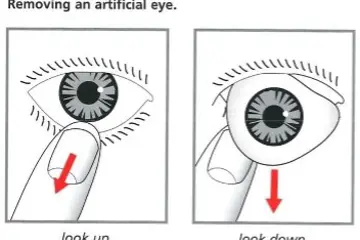
Removing a cosmetic shell
First ensure you wash your hands. Gently place the side of your index finger along the upper eyelash. Do not look in the mirror. Look down. Push your upper lid up until it reaches the top edge of the shell.
Now gently pull the eyelash towards your ear so it tightens. The shell will lift off the eye –make sure that you catch it with your spare hand. Wash both your hands and the prosthesis, and either re-insert it or dry it and replace it in its box. The image demonstrates this method.
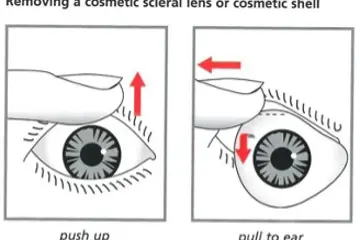
From time to time, you may experience some discharge. This is usually normal. If it is thicker than normal, please consult you GP or ophthalmologist.
Some patients find using a lubricant helpful to wearing a prosthesis. Your GP or a local pharmacy can assist with this.
Prosthetic eye frequently asked questions
I am struggling to come to terms with my condition. Who can I speak to?
It is completely understandable and normal to feel like this after having your eye removed, especially if you had some sight in your eye before the operation. Your emotions may fluctuate as you realise you are losing, or have lost, a part of you. You may also feel grief, sadness, bitterness and anger, and initially find it difficult to come to terms with having only one eye. Some patients have the sensation that the eye is still there or have temporary visual hallucinations or flashing lights. This is all quite normal and will improve over time.
If you would like to talk to someone about coping after having an enucleation you can contact a member of our support network.
We have also produced a series of videos on ‘coping with eye loss’ which you might find helpful.
How soon can I get my custom made prosthesis after surgery?
Due to the specialist nature of this work, getting your custom-made prosthesis or cosmetic shell will take some time. The timing of your initial appointments with us is done in the way to allow the socket to heal and settle from the surgery.
During surgery, you will be fitted with a conformer (clear shell placed in your pocket). Usually, you will be referred to us around six weeks after your surgery, once you have had your post-op review appointment and the surgeons have checked the socket and are happy that healing is progressing as expected.
We have listed some time frames for your information, but it is important to remember that all things are approximate, and each case is individual. This is given as a guide so that you know what to expect following surgery.
Will I need any further appointments with the ocular prosthetics department?
Yes. You will need to phone us (see contact details on first page) to book a ‘review & polish’ appointment for approximately 12-18 months later. This is because your prosthesis is made of a form of acrylic which needs to be polished from time to time to keep it comfortable long term. The polishing removes any marks or protein build up from the surface that can cause discomfort.
What will happen if I require a facial prosthesis?
Facial prostheses are supplied normally three to four months following exenteration (the removal of the entire contents of the eye socket, including eyeball, muscles, fat and tissues) to allow tissue to settle.
These are constructed of acrylic and/or silicone rubber. They are positioned and held in place by adhesives or are attached to your glasses. We can also provide prostheses that are attached to orbital bone retained implants for better adhesion. These are all manufactured on site.
The orbital area is moulded and the new face area sculpted in clay and wax to provide a symmetrical look with the other orbital area
Is the process the same for adults and children?
The process can be different for children if they are born with either anophthalmia (no eye/eyes) or microphthalmia (small eyes).
This is because the eye socket needs to be consistently expanded to ensure natural growth of the orbital area.
This is achieved by various methods over a few weeks and months (depending on the child), until it has been decided by either the paediatric consultant or the ocularist that a cosmetic prosthesis can be provided. At this point, a moulded prosthesis will be manufactured.
The moulding process will need repeating frequently to match the growth and encourage continued socket expansion.
Please be assured that our ocularists and surgical team have a great deal of experience and expertise in these more difficult cases.
Available support
Ocular oncology nurse specialists
Our ocular oncology nurse specialists, based at Moorfields Eye Hospital at City Road, are available to give you specialist advice.
They are located in the ocular oncology clinics.
Nurse counsellors
If you are finding it difficult to come to terms with your diagnosis and the treatment you require, you may like to talk to one of the nurse counsellors based at City Road.
Counselling provides an opportunity to talk things through, allowing you the time to explore your thoughts and feelings and to make sense of the way you feel.
You can call 020 7566 2385. Alternatively, you can ask your medical team or nurse specialist to refer you to one of the counsellors.
Friends ocular prosthetics buddy service
An initiative of the Friends of Moorfields, the buddy service puts ocular prosthetic patients going through what can be a very traumatic experience in contact with another Moorfields ocular prosthetic patient who has been through a similar procedure/experience and is trained by our nurse counsellors to provide practical peer support.
For more information, please contact the Friends team on 020 7251 1240, or 020 7253 3411 ext. 2027
Health information hub
The health information hub, managed by the
Friends of Moorfields is situated near the main entrance of Moorfields at City Road. Patients, their carers and families are welcome to drop by the hub and have an informal chat with our health hub support officer who can provide more information about services available at and beyond Moorfields.
Support available outside Moorfields
- Macmillan Cancer Support www.macmillan.org.uk
Macmillan provide practical, medical and financial support and advice for people going through cancer.
-
Changing Faces www.changingfaces.org.uk
A charity for people and their families who are living with conditions, marks or scars that affect their appearance.
- Chect (Childhood Eye Cancer Trust) www.chect.org.uk
- Maggie’s Cancer Support Service St Bartholomew’s Hospital London www.maggies.org
- Macs (Microphthalmia, Anophthalmia & Coloboma Support) www.macs.org.uk
